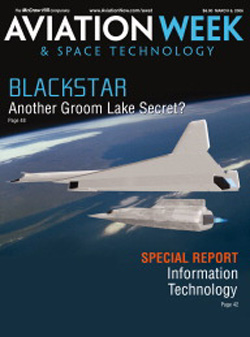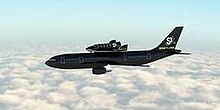
A spacecraft is a vehicle that is designed to fly in outer space and operate there. Spacecraft are used for a variety of purposes, including communications, Earth observation, meteorology, navigation, space colonization, planetary exploration, and transportation of humans and cargo. All spacecraft except single-stage-to-orbit vehicles cannot get into space on their own, and require a launch vehicle.

Spaceflight is an application of astronautics to fly objects, usually spacecraft, into or through outer space, either with or without humans on board. Most spaceflight is uncrewed and conducted mainly with spacecraft such as satellites in orbit around Earth, but also includes space probes for flights beyond Earth orbit. Such spaceflight operate either by telerobotic or autonomous control. The more complex human spaceflight has been pursued soon after the first orbital satellites and has reached the Moon and permanent human presence in space around Earth, particularly with the use of space stations. Human spaceflight programs include the Soyuz, Shenzhou, the past Apollo Moon landing and the Space Shuttle programs. Other current spaceflight are conducted to the International Space Station and to China's Tiangong Space Station.
Human spaceflight programs have been conducted, started, or planned by multiple countries and companies. Until the 21st century, human spaceflight programs were sponsored exclusively by governments, through either the military or civilian space agencies. With the launch of the privately funded SpaceShipOne in 2004, a new category of human spaceflight programs – commercial human spaceflight – arrived. By the end of 2022, three countries and one private company (SpaceX) had successfully launched humans to Earth orbit, and two private companies had launched humans on a suborbital trajectory.

Hermes was a proposed spaceplane designed by the French Centre National d'Études Spatiales (CNES) in 1975, and later by the European Space Agency (ESA). It was superficially similar to the American Boeing X-20 Dyna-Soar and the larger Space Shuttle.

A reusable launch vehicle has parts that can be recovered and reflown, while carrying payloads from the surface to outer space. Rocket stages are the most common launch vehicle parts aimed for reuse. Smaller parts such as rocket engines and boosters can also be reused, though reusable spacecraft may be launched on top of an expendable launch vehicle. Reusable launch vehicles do not need to make these parts for each launch, therefore reducing its launch cost significantly. However, these benefits are diminished by the cost of recovery and refurbishment.

A spaceplane is a vehicle that can fly and glide like an aircraft in Earth's atmosphere and maneuver like a spacecraft in outer space. To do so, spaceplanes must incorporate features of both aircraft and spacecraft. Orbital spaceplanes tend to be more similar to conventional spacecraft, while sub-orbital spaceplanes tend to be more similar to fixed-wing aircraft. All spaceplanes to date have been rocket-powered for takeoff and climb, but have then landed as unpowered gliders.

The Boeing X-20 Dyna-Soar was a United States Air Force (USAF) program to develop a spaceplane that could be used for a variety of military missions, including aerial reconnaissance, bombing, space rescue, satellite maintenance, and as a space interceptor to sabotage enemy satellites. The program ran from October 24, 1957, to December 10, 1963, cost US$660 million, and was cancelled just after spacecraft construction had begun.

The Boeing X-37, also known as the Orbital Test Vehicle (OTV), is a reusable robotic spacecraft. It is boosted into space by a launch vehicle, then re-enters Earth's atmosphere and lands as a spaceplane. The X-37 is operated by the Department of the Air Force Rapid Capabilities Office, in collaboration with United States Space Force, for orbital spaceflight missions intended to demonstrate reusable space technologies. It is a 120-percent-scaled derivative of the earlier Boeing X-40. The X-37 began as a NASA project in 1999, before being transferred to the United States Department of Defense in 2004. Until 2019, the program was managed by Air Force Space Command.

Dream Chaser is an American reusable lifting-body spaceplane developed by Sierra Space. Originally intended as a crewed vehicle, the Dream Chaser Space System is set to be produced after the Dream Chaser Cargo System cargo variant is operational. The crewed variant is planned to carry up to seven people and cargo to and from low Earth orbit.

A launch vehicle is typically a rocket-powered vehicle designed to carry a payload from Earth's surface or lower atmosphere to outer space. The most common form is the ballistic missile-shaped multistage rocket, but the term is more general and also encompasses vehicles like the Space Shuttle. Most launch vehicles operate from a launch pad, supported by a launch control center and systems such as vehicle assembly and fueling. Launch vehicles are engineered with advanced aerodynamics and technologies, which contribute to high operating costs.

Blackstar is the reported code-name of a secret United States orbital spaceplane system. The possible existence of the Blackstar program was reported in March 2006 by Aviation Week & Space Technology magazine; the magazine reported that the program had been underway since at least the early 1990s, and that the impetus for Blackstar was to allow the United States government to retain orbital reconnaissance capabilities jeopardized following the 1986 Challenger disaster. The article also said that the United States Air Force's Space Command was unaware of Blackstar, suggesting it was operated by an intelligence agency such as the National Reconnaissance Office.

The Intermediate eXperimental Vehicle (IXV) is a European Space Agency (ESA) experimental suborbital re-entry vehicle. It was developed to serve as a prototype lifting body orbital return vehicle to validate the ESA's work in the field of reusable orbital return vehicles.

Thales Alenia Space is a joint venture between the French technology corporation Thales Group (67%) and Italian defense conglomerate Leonardo (33%). The company is headquartered in Cannes, France.

The XCOR Lynx was a proposed suborbital horizontal-takeoff, horizontal-landing (HTHL), rocket-powered spaceplane that was under development by the California-based company XCOR Aerospace to compete in the emerging suborbital spaceflight market. The Lynx was intended to carry one pilot, a ticketed passenger, and/or a payload above 100 kilometres (62 mi) altitude. The concept was under development since 2003, when a two-person suborbital spaceplane was announced under the name Xerus.

USA-212 was the first flight of the Boeing X-37B Orbital Test Vehicle 1, an American robotic vertical-takeoff, horizontal-landing (VTHL) spaceplane. It was launched aboard an Atlas V rocket from Cape Canaveral on 22 April 2010, and operated in low Earth orbit. Its designation is part of the USA series.

Swiss Space Systems (S3) was a company that planned to provide orbital launches of small satellites and crewed sub-orbital spaceflights. The company was based in Payerne in western Switzerland, near Payerne Air Base, where it planned to build a spaceport in 2015. Suborbital spaceplanes were to be launched from an Airbus A300, giving the spacecraft more initial speed and altitude than if it were launched from the ground. The spacecraft, in turn, would release a disposable third stage.
The DARPA XS-1 was an experimental spaceplane/booster with the planned capability to deliver small satellites into orbit for the U.S. Military. It was reported to be designed to be reusable as frequently as once a day, with a stated goal of doing so for 10 days straight. The XS-1 was intended to directly replace the first stage of a multistage rocket by taking off vertically and flying to hypersonic speed and high suborbital altitude, enabling one or more expendable upper stages to separate and deploy a payload into low Earth orbit. The XS-1 would then return to Earth, where it could ostensibly be serviced fast enough to repeat the process at least once every 24 hours.

The Space Rider is a planned uncrewed orbital lifting body spaceplane aiming to provide the European Space Agency (ESA) with affordable and routine access to space. Contracts for construction of the vehicle and ground infrastructure were signed in December 2020. Its maiden flight is currently scheduled for the third quarter of 2025.
The Chinese reusable experimental spacecraft is the first reusable spacecraft produced by China. It embarked upon its initial orbital mission on 4 September 2020. According to media reports, the CSSHQ is launched into Earth orbit in a vertical configuration while enclosed within the payload fairings of a rocket like a traditional satellite or space capsule, but it returns to Earth via a runway landing like a conventional aircraft; the landing is conducted autonomously. In the absence of any official descriptions of the spacecraft or photographic depictions thereof, some observers have speculated that the CSSHQ may resemble the X-37B spaceplane of the United States in both form and function.
















